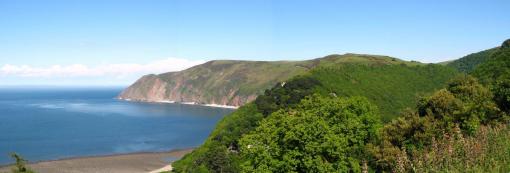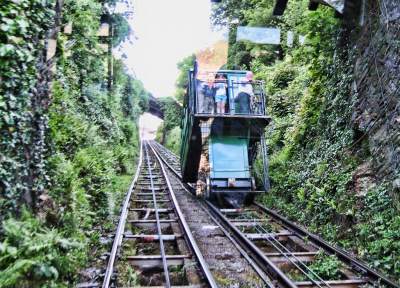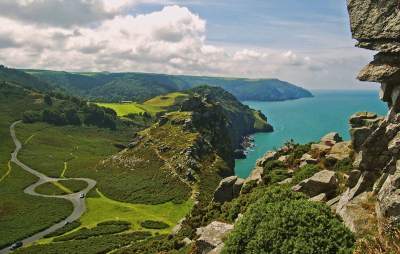
Set amongst the spectacular scenery of an area known as England’s Little Switzerland is Lynton, a small Victorian town with a selection of shops, tea-rooms and cafés. The town boast few buildings of particular note but the Town Hall is worth a second glance, as is the strangely named Valley of Rocks Hotel. The Lyn and Exmoor Museum is housed in St Vincent’s Cottage. It has some interesting exhibitions of Exmoor life, including information about the local lifeboat and the Lynton and Barnstaple Railway.
Both Lynton and Lynmouth owe a great deal to Sir George Newnes, a publisher who lived at Hollerday House on Hollerday Hill above Lynton. This mansion unfortunately burned to the ground in 1913 in mysterious circumstances. The house was built. The steep gradient between the two villages had always been a deterrent to visitors and a hard climb for the locals. In 1887 Newnes and Thomas Hewitt began to lay a 900 foot twin track up the steep gradient. The unique water operated cliff railway was opened in 1890 and, apart from needing new track in 1908, operates now as it always has.
In the early days of motoring the railway transported cars up the gradient. A few years later Newnes became involved in a project to build a light railway linking Lynton and Barnstaple. Although the project was plagued with difficulties, they persevered and the first train ran on 11 May 1898. There were initially four locomotives and sixteen coaches and the average speed was about 12 mph. The route crossed Chelfham Viaduct, the largest narrow gauge railway viaduct ever built in Britain.
Lynmouth is a pretty harbour nestling beneath the cliffs. It is a quiet retreat where one can wander between the quaint fishing cottages that line the narrow street down towards the quay and the distinctive Rhenish Tower. Two rivers, the East Lyn and the Hoaroak, come together just inland from the harbour at Watersmeet, pour down a gorge and flow through the village to the sea. In 1952 the rivers flooded and a torrent of water washed many cottages into the sea with the loss of 34 lives and destruction of nearly 100 homes. The Rhenish Tower at the end of the Quay was built in the late 1850s by General Rawdon to store salt water to supply his house with sea baths. The tower was badly damaged during the disaster but was later faithfully reconstructed.
Lynton lies on the northern edge of the West Country peninsula in an area of incomparable beauty. Bracken and heather clad the sweeping hills and valleys nestle between these and spectacular cliffs. Rivers wind their way through deeply wooded valleys to the sea, occasionally interrupted by tumbling waterfalls. This is the Exmoor of Lorna Doone, described in the novel by R.D.Blackmore.
The remarkable Valley of the Rocks, after which the hotel was named, is just over a mile from Lynton. This dry valley is unlike any other on the north coast. Created during the Ice Age, it has spectacular weathered rock formations with names such as The Devil’s Cheesering and Ragged Jack. Wild goats populate the valley can be seen scrambling amongst the rocky outcrops.
The Victorian fishing lodge at Watersmeet is now run by the National Trust. The area is worth visiting to see the dramatic waterfalls and spectacular autumn and spring colours of the vegetation. Inland are numerous walks through the rugged scenery of the Exmoor National Park. There are over 600 miles of marked footpaths. Exmoor has abundant wildlife, including ponies, sheep and the lovely red deer that graze the open moorland. Overhead one might see falcons, buzzards and even the rare merlin.


